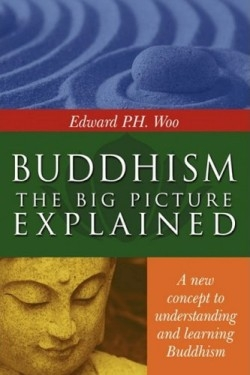It looks like you've stumbled upon a page meant to be read by our code instead of viewed directly. You're probably looking for this page.
Buddhism
The Big Picture Explained
There’s no guarantee a reader will reach nirvana—possessing true bliss—after completing this book but Edward P. H. Woo does a workman-like job of setting down the premises of Buddhism the religion he believes can provide that type of heaven.
That’s Woo’s task: defining Buddhism as a religion rather than a philosophy. Buddhists believe in creation although not necessarily a creator. Adherents also believe that consequences follow action. In some contexts this is similar to Christians classifying an action a “sin” and its consequence “eternal punishment.” But beyond that point Buddhism begins to follow its own path. Buddhists do not seek heaven as a place but rather “enlightenment” as a state of realizing one’s “self-nature.”
That’s why early on in this book Woo poses the question “What are we supposed to know to get enlightened?”
The answer will bring us to the two outstanding features of Buddhism….The two features are (1) the appreciation of the human mind (self-nature) and (2) the inevitable relationship between cause and consequence.
Woo is ethnic Chinese and although he was educated in the West he has spent most of his professional life as a lawyer in Hong Kong. This background and his extensive studies with Buddhist masters and reading of ancient Chinese texts have made it evident to him that Westerners often misinterpret the precepts of Buddhism. “In many publications on Buddhism available in English we notice that the ‘Four Noble Truths’ are often described as the essence of Buddhism” Woo writes. But he notes that the essence of Buddhism should be regarded as a quest for the realization of our “perfect and immaculate” selves which are obscured by “greed hatred and delusion and this blockage produces suffering.”
Buddhism originated in what is now India in the sixth century BCE. It arose from the spiritual teachings of a prince (Siddhartha Gautama) who took the name Shakyamuni which means “compassion” and “tranquility and purity.” As it spread across Asia Buddhism’s teachings were refined and explained in writings known as sutras.
With this book Woo hopes to bring an understanding of Buddhism to those who are unfamiliar with the religion; to explain it to people of other faiths without intent to convert; and to offer a comprehensive explanation to those who might harbor opinions that Buddhism is an inferior faith.
Woo’s writing is accessible rather than literary his opinions are straight-forward and he offers a thorough and intelligent explanation of his faith in this information-packed book.
Those unfamiliar with the religion will soon understand that Buddhism itself is both simple and complex. For example precepts and ideals are often presented as numbered lists—the Six Paramitas the Four Stages to Monitor Our Cultivation the Six Harmonies in Communal Cultivation. Without close reading and perhaps detailed note-taking the lists can become confusing. Some of Buddhism’s theology requires a suspension of Western logic and acceptance of mystical ideas that may seem to present themselves as mutually exclusive. The concept of “emptiness” is an example:
To feel that there is nothing which is “me”
Without worry or doubt that anything might be “me”;
To feel that there is nothing which is “mine”
Without worry or doubt that anything might be “mine.”
Readers should also be aware that Woo’s approach to Buddhism seems Sino-centric. He often cites a master called Chin Kung and while he mentions the Zen school there are no references to the factionalism that plagues Buddhism a state much like the divisiveness within other world religions.
Those with a cursory interest in Buddhism will find this small book worthwhile. Others may find their interest in Buddhism deepened by this book which offers a solid framework for beginning a more intensive study.
Disclosure: This article is not an endorsement, but a review. The publisher of this book provided free copies of the book and paid a small fee to have their book reviewed by a professional reviewer. Foreword Reviews and Clarion Reviews make no guarantee that the publisher will receive a positive review. Foreword Magazine, Inc. is disclosing this in accordance with the Federal Trade Commission’s 16 CFR, Part 255.
